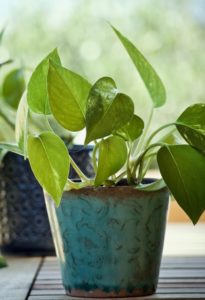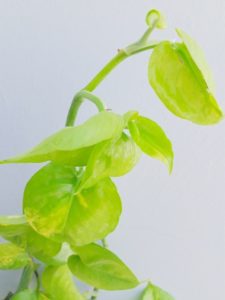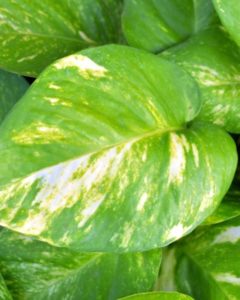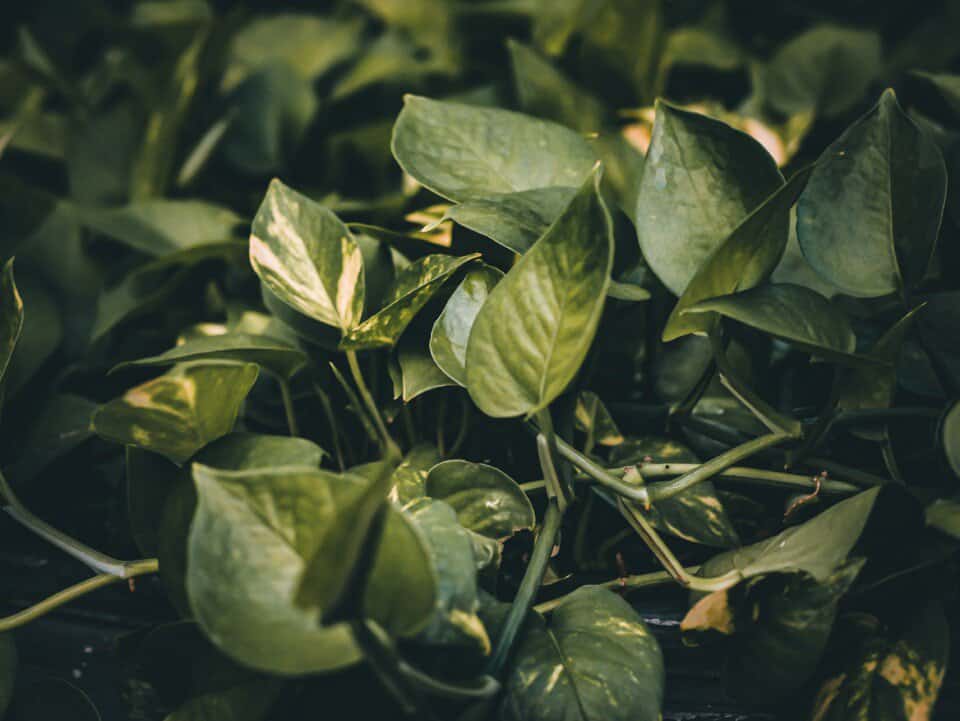Some links in the post are affiliate links and I get a commission from purchases made through some links found in the post.
The Pothos plant is a perfect houseplant that can be easy to care for and will be a beautiful decor for your home or office. Since pothos is a tropical plant, you may be wondering what would be the ideal pothos humidity level?
Pothos plant loves warm environments and high humidity, however, it can be easily adapted to different conditions.
The perfect pothos humidity level is from 50% to 60%. However, as long as the humidity is above 40%, this green beauty will be fine.
However, you may need to know more than this in order to create good conditions for your beloved pothos plant.
In this article, we will discuss not only what is the ideal humidity level for pothos, but also how to create the perfect environment for them.
What is the Ideal Humidity for a Pothos?
 Pothos plant is also known as Epipremnum aureum and is native to French Polynesia.
Pothos plant is also known as Epipremnum aureum and is native to French Polynesia.
They especially thrive in tropical and sub-tropical regions and if the environmental factors are suitable for them, they grow pretty fast.
Typically, They grow up tree trunks and have leaves that are much bigger than what we are used to seeing indoors.
Pothos plants are acclimated to temperatures ranging from 68 to 85 degrees Fahrenheit in these tropical climates.
In the regions where the pothos plant grows naturally, Temperatures seldom if ever, fall below 65 Fahrenheit and do not go higher than 85 Fahrenheit either.
Therefore, those plants do not really enjoy the higher temperatures.
High humidity levels are typical in tropical rainforests. In their native environments, pothos lives in humidity levels of between 60 and 80 percent.
These circumstances are caused by the abundance of plants and the high moisture content brought on by the regular rains.
Fortunately, Pothos plants (even variegated pothos varieties) will flourish inside even if the exact required conditions are not provided.
They are exceptionally adaptive plants, and if their other demands are constantly satisfied, they will thrive in a slightly broader temperature range and in significantly lower humidity.
How to Find out What Humidity your Home is?
Using a hydrometer is the only reliable approach to detecting relative air humidity. Fortunately, these little tools are affordable and simple to use.
These days, they are all more likely to be digital and, when activated, frequently provide you with both the room’s temperature and pothos humidity level.
However, before the use, take into account that various areas of a room could have higher or lower humidity levels, so make sure you are getting your reading close to the plant.
What you could do that would make your houseplants happy is to have two or three separate hydrometers scattered around your indoor garden.
You will be able to evaluate the pothos’s humidity levels in every location and respond appropriately as a result.
The hydrometer’s effectiveness depends on how frequently you check it. Take into consideration that a variety of elements, including weather, heating, and soil conditions, can affect humidity.
You can only get a precise picture of the whole situation by often checking the hydrometer.
How to Increase the Humidity in your Home
In locations where the climate is dry, low humidity can bring trouble and difficulties to the indoor plants.
Fortunately, there are a few techniques to raise the humidity level surrounding your plants and provide them with the ideal environment.
Misting is frequently advised to increase pothos humidity. While there are certain advantages to this, the situation doesn’t work and makes the humidity better over the long run.
You’re better off using one of the other techniques unless you want to be spraying your houseplants numerous times each day.
One of the most recommended methods is the creation of a mini-ecosystem. This can be done by Grouping your houseplants together to raise the pothos humidity level.
This one is the cheapest and easiest method. When numerous plants are placed close to one another, the humidity level rises, which benefits all of the nearby plants.
You shouldn’t have any problems with bugs or illnesses if you make sure that the plants have ventilation between them.
Having the humidifier will greatly affect your plant’s health. When you have them at home, they provide the perfect range of humidity for your plants and not only provide but maintain it too.
Another famous and often practiced method is having aquariums and bowls of water placed in the room. However, having the gravel tray made can be easier and cheaper.
The gravel tray method is when you put the plant on top of the saucer that is filled with gravel, pebbles, and water.
But the tray must not be topped and filled all the way over the gravel. This will cause the evaporation of water exactly in the vicinity of the plant, and well, we do not want that to happen.
The indoor greenhouse is a relatively new addition to the home gardener’s arsenal. These are merely little greenhouses that let you retain your plant in a smaller, transparent plastic or glass-walled environment.
And it is obvious, that in the smaller space, it is easier to have a higher humidity level which our pothos plant requires. This method may not look beautiful, but it will eventually help the plant in growth by providing enaugh moisture.
What are the Signs the Humidity is not Ideal for your Pothos?
 In most cases, low humidity is a much more frequent issue than excess humidity. This is due to the fact that our beloved indoor plants are native to damp tropical regions.
In most cases, low humidity is a much more frequent issue than excess humidity. This is due to the fact that our beloved indoor plants are native to damp tropical regions.
However, if you are growing your Pothos in a bathroom, this may not be an issue.
Excessive pothos humidity is more frequently seen in commercial greenhouses than it is in the typical residential household.
We heat our homes and use double glazing to trap the air inside, which is one of the reasons they have such low humidity levels.
There are several symptoms that will tell you that your pothos plant does not like the humidity level provided in the air.
- The edges or tips of the leaves become brown, dry, and crispy.
- Leaves are wilting and drooping.
- Leaves getting a yellow color and falling.
Do Pothos Need a Humidifier?
Pothos Plants enjoy the humidifiers. They provide a higher humidity level which is essential for tropical plants. Even more, if the air at your home is dry, then the use of a humidifier can be a great decision.
Purchasing a humidifier is the finest and most dependable approach to increasing the pothos humidity level.
Humidifiers can play an important role in houseplants’ development, despite the fact that they can be expensive.
You will receive the happiest plants conceivable thanks to their significant improvements in the environment and the creation of the ideal circumstances for optimal growth.
Do Pothos Like to Stay Moist?
Yes, pothos not only tolerates but also likes moisture. The pothos humidity level in the original tropical habitat is frequently very high However, their natural environment is in the wild with a high level of ventilation.
To prevent fungus and mold from growing on the soil of the pothos plant, you must also make sure there is enough air circulation in a home with high humidity.
The leaves of the pothos will turn a yellow color and finally fall off if fungus or mildew spreads.
A pothos should typically be watered once per week in the summer and twice per month in the winter. Pothos grow best when the soil gets dried between waterings, so keep the soil wet but watch out not to overwater.
You should water the plant more often if the leaves are drooping or turning brown. You could be watering your plant too much if the leaves turn yellow. Overwatering might lead to root rot.
Keep your pothos out of the water unless it is being propagated in the water. Pothos can grow in both soil and water, however, they find it difficult to transition between the two.
If a pothos plant is grown in soil from the beginning, it will flourish in the soil the most. However, if it has started in the water, then will do just fine to grow in the water.
Do Pothos like to be Misted?
The misting plants in order to increase the humidity level have been done for years now.
Gardeners who had plants that needed more humidity would simply mist the leaves with a thin spring of water, which would immediately increase the humidity level.
The effectiveness of this approach has recently come under scrutiny in research.
The results of the research indicate that even though humidity does increase when misted, this effect disappears in a very short period of time.
Once the plant dries out, it rapidly goes back to the original humidity level. Additionally, it appears that soaking the leaves may increase the risk of illness or fungal issues.
Even though it will be temporary, Misting pothos plants will enhance humidity, supply water for the plant and leaves, and provide you with a simple approach to nourish your plant.
For your pothos, misting may be a terrific technique to temporarily enhance the humidity and encourage faster growth in a dry climate.
How to Mist your Pothos.
 It’s essential to keep in mind that the pothos s a very resilient indoor plant that can withstand a broad variety of humidity conditions.
It’s essential to keep in mind that the pothos s a very resilient indoor plant that can withstand a broad variety of humidity conditions.
Because it is so hardy, it is one of the most common indoor plants. You can mist your pothos just like you do for other plants.
- Get the spray bottle and fill it up with lukewarm water.
- Make sure that your water is distilled. Otherwise, if you use tap water, leave it out for 24 hours so the chlorine and other additives evaporate.
- Additionally, you can add the foliage cleaner and shiner solution.
- Gently spray the water to the leaves of your beloved pothos plant.
Can Pothos Survive High Humidity?
A pothos plant comes from a region that has a very high humidity level. Therefore, the plant itself loves the high moisture around it.
However, what is exactly meant by “high humidity”. When we talk about the higher humidity level, we mean the range between 50 percent and 70 percent.
However, if the moisture level in the air is higher than this, they will do fine too. Pothos’ Humidity level can go as high as 85 percent.
Higher humidity may not harm the pothos plant straightaway, however, it can cause several serious problems if not handled properly.
The high humidity level and moisture can be reasons for mildew and fungus. The most effective strategy to avoid mildew and soil fungus, both of which can lead to illness, is to have enough air circulation.
To reduce the chance of fungal diseases in your pothos, use a fan or leave the doors and windows open to circulate the air in an area with high humidity.
Wipe clean your pothos leaves if mildew or mold has caused them to turn fuzzy. Rapport the plant immediately and use new potting soil. If your home is excessively humid, it’s also a good idea to put a dehumidifier close to the pothos.
This should just be a temporary measure to get rid of too much moisture in the air and stop mold from growing.
Generally, one of the major strategies for your pothos to develop quicker is to make sure your home has the high humidity they want.
Can you Keep Pothos in the Bathroom?
Some plants, that are high humidity lovers and tolerate lower light conditions can be kept in the bathrooms. This not only provides the plant with enough humidity level but also makes a perfect green decoration.
The pothos plant is ideal to place on a bathroom shelf or counter since it prefers moderate to low, indirect light.
Even though the pothos plant does not necessarily need the additional humidity, It can be a wonderful choice for a bathroom since it can withstand reduced light levels and inconsistent watering.
It’s also a hardy plant and can be very easy to care for.
Final Thoughts
 Even though the pothos plant is pretty resilient, humidity still plays an important role in its health and happiness.
Even though the pothos plant is pretty resilient, humidity still plays an important role in its health and happiness.
Even if you think that your plant is doing fine, if you create the perfect humidity level for it, you will definitely see the difference. Therefore, it is important to know what range of humidity is good for pothos plants.
As we already discussed above, the perfect Pothos humidity level is from 50 to 60 percent. This will give your plant all that is needed for happiness and thriving.

